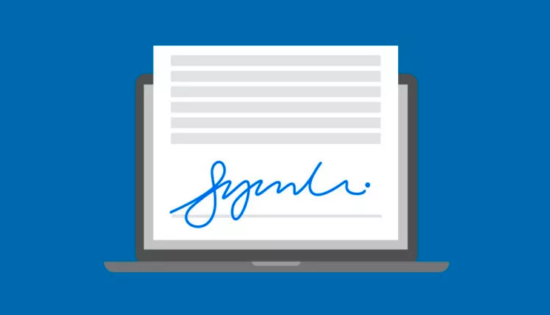Electronic signatures (or e-signatures) have become nearly ubiquitous in everyday life and business—from confirming your agreement to terms and conditions on a website to using e-signature tools to sign a work contract.
But are electronic signatures legally binding? Can—and should—you use e-signatures instead of traditional handwritten signatures on documents in your legal practice?
The UK typically embraces a permissive approach toward electronic records and signatures. The Law Commission has affirmed that electronic signatures are valid for executing documents, even those with a statutory requirement for a signature. Both the Electronic Communications Act 2000 and the Consumer Rights Act 2015 acknowledge the legal validity of electronic signatures. They stipulate that a contract cannot be invalidated solely due to its electronic signature.
Moreover, the EU’s eIDAS regulation and UK eIDAS establish a legal framework for electronic signatures, guaranteeing their evidentiary admissibility and affirming that qualified electronic signatures meet legal standards similar to handwritten signatures. However, some people still opt to use traditional handwritten signatures—even in instances where e-signatures are legally binding, more convenient, and more secure than wet signatures.
From understanding the legal framework behind e-signatures to useful tips, tools, and best practices for electronic signatures, in the following post, we’ll outline what you need to know about whether electronic signatures are legally binding. We’ll also offer tips for how e-signatures can help streamline document processes and improve efficiency at your law firm—when used correctly.
What is an electronic signature?

First things first: What exactly do we mean when we refer to an “electronic signature”?
The Electronic Communications Act 2000 defines an electronic signature as “so much of anything in electronic form as – (a) is incorporated into or otherwise logically associated with any electronic communication or electronic data; and (b) purports to be incorporated into or associated with the communication or data for the purpose of establishing the authenticity of the communication or data, the integrity of the communication or data, or both”
What is an e-signature?
An e-signature, short for electronic signature, is a digital representation of a person's signature used to sign documents electronically. It serves as a legally binding way to indicate consent or approval on electronic documents.
Put simply, an electronic signature requires the signer to take some sort of electronic action with the clear intent of that action functioning as a “signature.”
In practice, an electronic signature can take many different forms, such as:
- Clicking an “I Agree” or “I Accept” button to signify consent with terms on a website
- Typing your name and submitting a form online
- Signing your signature with your finger on a mobile device
- Using an electronic signature platform to e-sign a document
Exploring the legality of electronic signatures
Benefits and advantages of using electronic signatures
When used appropriately, there are numerous reasons why lawyers and clients may prefer to use e-signatures over traditional handwritten signatures, including:
- Added convenience. Modern e-signature technology makes it easy to sign documents remotely—anywhere and at any time. This means less time and expenses to collect signatures, improving legal operations in your firm. And, from a client’s perspective, a smoother and more convenient signing experience can add to a more positive overall client experience.
- Easier document management. Once an e-signature is collected, there’s no need to scan or physically mail documents, and documents can be easily managed electronically. This leads to time and effort saved on administrative tasks.
- Less paper. Whether or not your law firm is fully paperless, e-signatures reduce paper consumption. In this way, e-signatures can reduce a law firm’s paper, printing, and postage costs.
- Added security. Many modern e-signature programs offer more security than traditional wet signatures on paper. Digital encryption and authentication can help ensure the integrity of electronic signatures (for example, against forgery).
- Digital audit trails. When using e-signature software to facilitate the electronic signing of documents, most platforms will record and time-stamp each action taken in the process (such as who signed a document, their IP address, etc.). This generates a detailed audit trail for the signature process, which can help to establish authenticity (which may be useful in court should there be disputes regarding signature authenticity).
You may like these posts
Ensuring legally binding electronic signatures
Security measures to prevent tampering with electronic signatures

As with any electronic data handled by law firms, it’s crucial to take steps to ensure the security of and prevent tampering with electronic signatures. While nothing is foolproof, certain measures and best practices can help keep electronic signatures and their documents secure.
First and foremost, it’s essential that law firms use the right tools and technologies. Choosing reputable e-signature tools that follow strict security standards is one of the most important steps law firms can take to help maintain the legal validity of electronic signatures.
DocuSign and Adobe Acrobat Sign, for example, both use multiple security protocols like data encryption, authorised user authentication, and audit trails.
To learn more about data security for law firms, read our guide here.
With the help of secure e-signature tools, you can also look for security measures to help prevent tampering with electronic signatures, such as:
- Authentication. Requiring robust, strong user authentication methods (such as multi-factor authentication, passwords, or biometric authentication measures) to ensure authorised signers are signing.
- Encryption. Use tools with strong encryption to help safeguard and prevent unauthorised access or tampering of the signature or document.
- Audit trails. By recording all of the actions linked to the signing process for a document (such as viewing, editing, and signing the document), digital audit trails make it easier to track any unauthorised access or interaction with documents and help deter tampering.
- Digital certificates. Issued by a trust service provider or certification authority, digital certificates are electronic “credentials” that help confirm someone’s identity online. Electronic signature platforms often use digital certificate management as part of their security measures to help prevent tampering.
Are electronic signatures valid in court?
In many instances, yes—e-signatures are typically considered valid evidence in court, using the same criteria that would apply to traditional signatures. In fact, because e-signatures can employ additional security measures (such as audit trails and authentication), electronic signatures may even provide stronger court-admissible evidence than traditional signature methods.
Electronic signature laws in the United Kingdom and European Union
European Union

In 2016, the European Union’s 27 countries adopted the Electronic Identification, Authentication, and Trust Services (eIDAS) Regulation. This regulation allows EU countries to use e-signatures in cross-border agreements. It also ensures that electronic signatures are generally admissible as evidence in EU courts.
Under the eIDAS Regulation, there are three types of electronic signatures:
- Electronic signatures, or “simple” electronic signatures that basically indicate a signer’s acceptance or approval.
- Advanced electronic signatures, which fulfill additional requirements for signer ID verification, security, and tamper sealing.
- Qualified electronic signatures, which meet advanced electronic signature requirements and are backed by a qualified certificate.
United Kingdom

The United Kingdom accepts electronic signatures as legally binding, in most circumstances, if they meet certain criteria. In the United Kingdom, the Electronic Communications Act 2000 (ECA 2000), the Electronic Signatures Regulations 2002, and the UK eIDAS Regulations establish the rules for electronic signatures.
Cross-border implications and challenges of using electronic signatures
When it comes to cross-border transactions and electronic signatures, it’s important to learn and understand the laws and regulations of the countries in which the signees are based. It’s essential to know and comply with the legal requirements necessary for electronic signatures to be valid and legal for each jurisdiction involved.
Some countries may also have specific requirements related to the technology used when collecting electronic signatures. Here again, be sure to check that electronic signatures comply with any mandated processes or technology to ensure they are legally binding.
To help expand your understanding of the global legality of electronic signatures, the following guides and resources may be good places to start:
- Read the Electronic Signatures in Global and National Commerce (ESIGN) Act here.
- The Electronic Signature & Records Association (ESRA) offers a variety of resources here.
- DocuSign’s online eSignature Legality Guide offers a country-by-country summary of current e-signature laws and rules here.
- Read Adobe’s guide to Electronic Signature Laws & Regulations in the United States here.
Best practices for electronic signatures
Lawyers and law firms can benefit from using e-signatures, where appropriate. While it’s important to do your own research on which rules and regulations apply to your jurisdiction and situation, the following best practices can help you stay compliant and streamline your workflows when using electronic signatures:
- Use reputable, secure e-signature platforms. By choosing e-signature tools that maintain high-security standards and comply with legal standards, you can make it easier to stay compliant, with less work on your part.
- Stay up-to-date with legal requirements for electronic signatures. Take the time to learn the law governing the use of electronic signatures for your jurisdiction, and stay on top of any changes or updates.
- Use authentication methods. Take advantage of authentication measures (such as multi-factor authentication) used to ensure that the identity of signatories is correct.
- Document the process. Have a clear process, preferably in writing, for how electronic signatures are handled at your firm. This may include everything from the step-by-step process of collecting signatures to your procedures for the storage and retention of documents signed electronically.
Tips for implementing electronic signature solutions
The right technology goes a long way when it comes to adopting electronic signature solutions at your firm. Consider the following when weighing your options:
- Compliance. Any e-signature tool you use at your firm should comply with the rules and regulations governing electronic signatures in your jurisdiction.
- Ease of use and functionality. Choose a tool that is easy to navigate and use, both for you and your clients when signing.
- Security. Look for e-signature tools that employ high-security standards and features, such as authentication, encryption, and audit trails.
- Support. As with any tech tool you consider using, make sure that there is adequate support and assistance available should any questions arise.
- Integrations. If your electronic signature platform can integrate with other legal tech tools, you can unlock further efficiency and streamlined workflows. Clio, for example, integrates with popular e-signature solutions like DocuSign.
On the topic of integrations, Clio has a few options for e-signature capabilities that integrate directly with your law practice management and client onboarding tools.
- Clio Grow features integrated e-signature technology, which makes it fast and simple to streamline and automate your legal client onboarding process.
- With Clio Manage’s integration with Dropbox Sign, you can easily prepare documents and then send them to recipients for e-signatures.
This information applies only to practices in the UK. This article is provided for informational purposes only. It does not constitute legal, business, or accounting advice.
We published this blog post in May 2024. Last updated: .
Categorized in: Business, Technology






